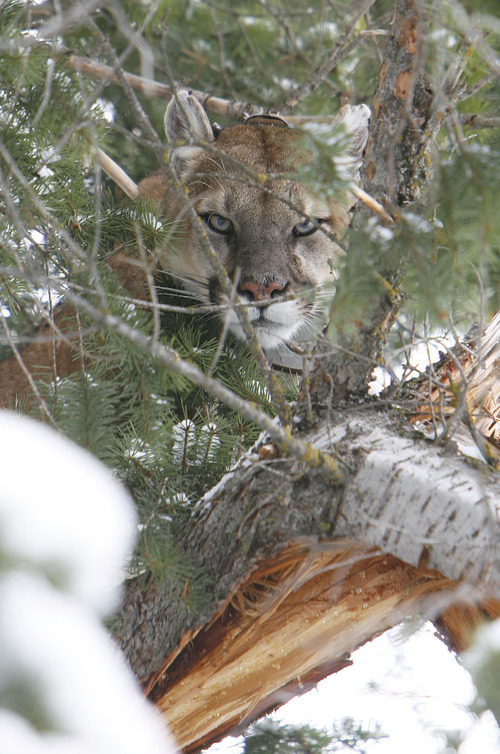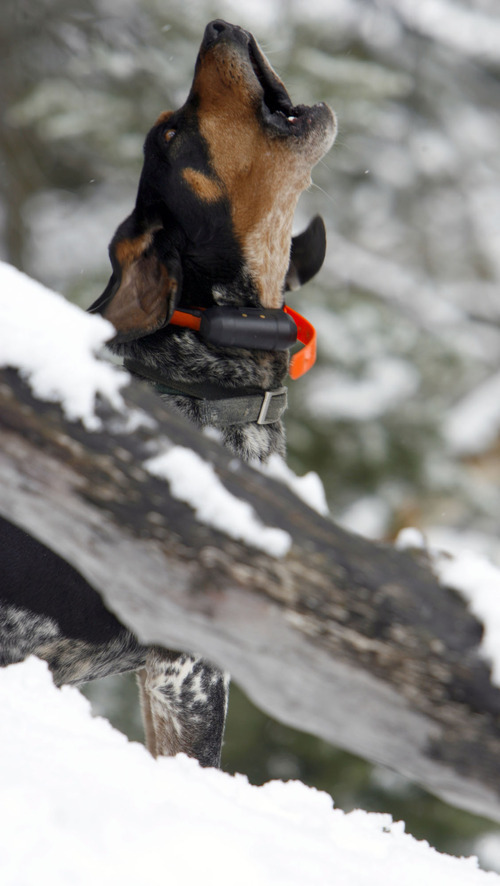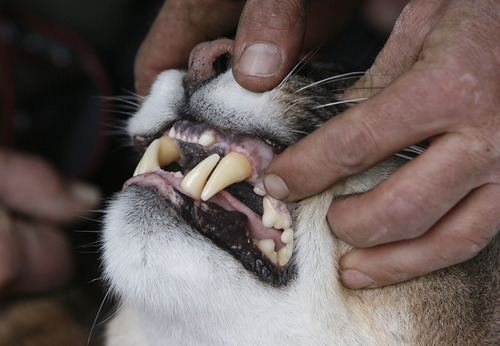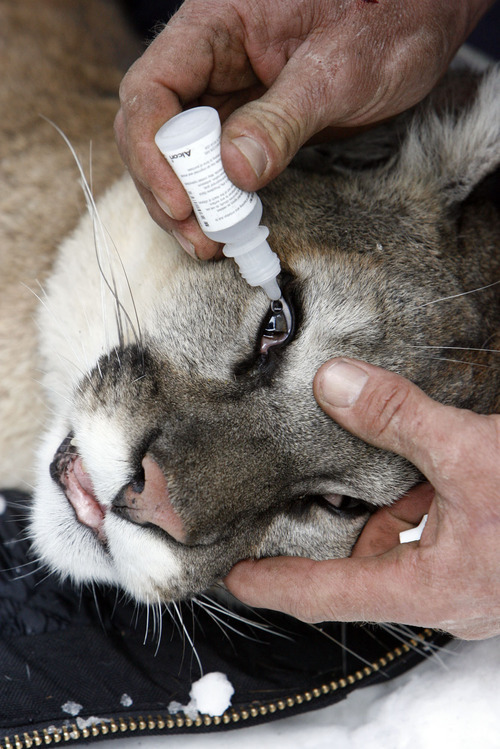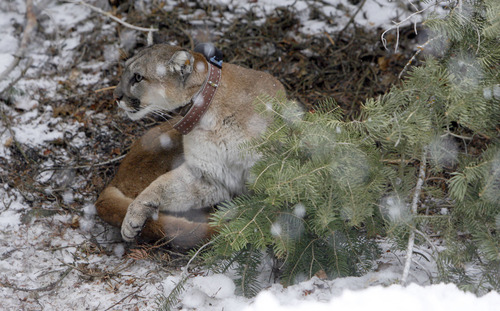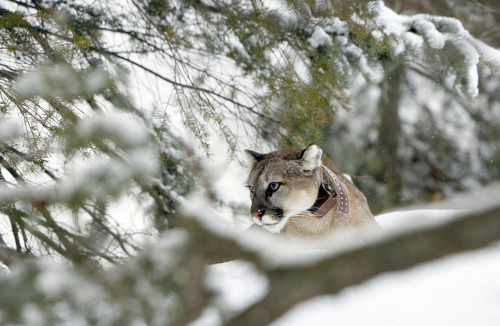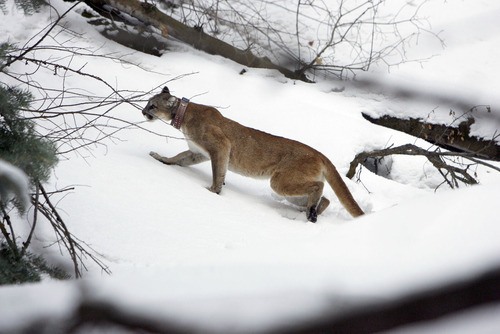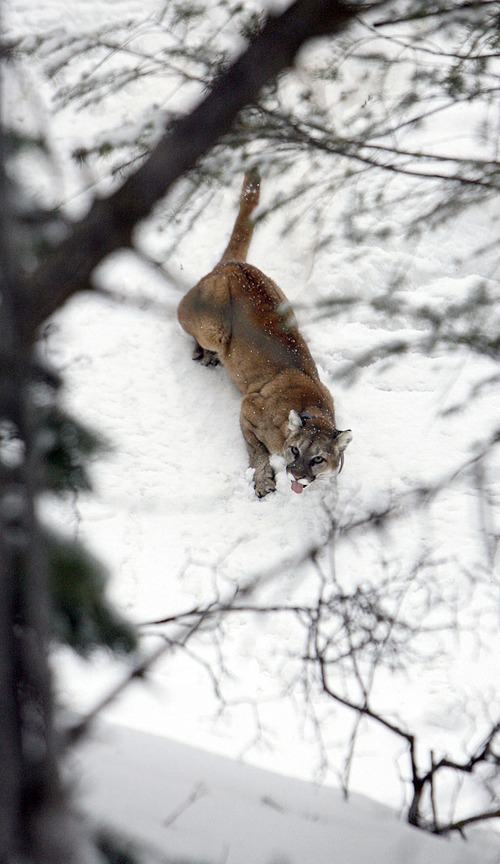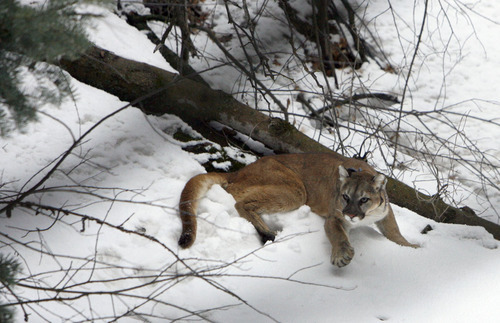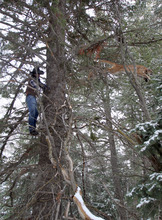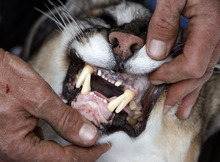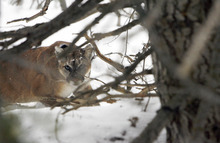This is an archived article that was published on sltrib.com in 2011, and information in the article may be outdated. It is provided only for personal research purposes and may not be reprinted.
Oquirrh Mountains, Utah County • Perched 25 feet up the tall, but sparse, spruce tree, the mountain lion cautiously kept tabs on the yapping dogs on the ground. One managed to climb five feet up the tree before falling back to the earth and trying again.
Dogs may not be able to climb trees, but humans are a different story. Incessant barking led seven men to the base of the tree where the lion stood straddling open air over two branches. It was a precarious position. When one of the men threw a rope over his shoulder, holstered a handgun and started to climb, she had seen enough.
The lion moved quickly to the hill side of the tree and, just as Mclain Mecham was about to shoot from a scant 7 or 8 feet away, the lion launched herself 20 feet out of the tree. Deep snow did little to slow the feline as she hit the ground running. The dogs were untied and the chase was on again.
Built for short bursts of speed to catch prey rather than marathon chases, the lion raced up another tree a canyon away. Mecham's tranquilizer dart found flesh this time and, once the lion was safely asleep, he moved quickly up the tree. The rope was looped under her front legs and the animal was lowered gently to the ground where researchers moved her to a clearing.
Similar scenarios have taken place for more than 15 years on the Monroe Mountains in south central Utah and the Oquirrh Mountains on the west side of the Salt Lake valley. The research is being conducted by Utah State University with funding and direction from the Utah Division of Wildlife Resources.
The research was intended to help state biologists design methods to produce mountain lion population estimates in Utah, where they live essentially anywhere mule deer can be found.
Other cougar research angles include determining preferred prey species and the rate of kills, tracking reproductive rates and dispersal and how lions cope with advancing human development.
"We have watched homes push up against the Oquirrhs during the life of the research," said Michael Wolfe, a professor of wildlife sciences and wildlife science adviser at USU. "We are looking at where they go when this happens and what animals do when that urban wildland interface advances."
Wolfe said the Oquirrh Mountains lions — also known as cougars, panthers and pumas — seem mostly "nonchalant" and "ambivalent" to the encroaching homes, at least thus far.
"We see some of the older females that have a hard time making a kill utilizing road kill on occasion. They, in turn, also sometimes become road kill," Wolfe said.
The cougar research projects helped David Stoner earn a master's and recently, a Ph.D., at USU.
Mclain and his brother Clint Mecham — who handles captures on the Monroe Mountains — have captured 235 individual lions since 1996 (91 on the Oquirrhs and 144 on the Monroes).
One of those 235 lions became well-known in the wildlife world. F31 was captured on the north end of the Oquirrh Mountains on Feb. 9, 2005, and fitted with a radio/GPS collar. She was tracked by radio signal until March 3, when she disappeared.
On Feb. 10, 2006, biologists with the Colorado Division of Wildlife let the Utah researchers know F31 had been killed by a hunter near Meeker, Colo. She was more than 220 miles due east of the place she was originally collared. Stoner said the GPS track showed she traveled an actual distance of more than 833 miles.
Along the way, F31 crossed Interstate 15 near Scipio and then headed north on the east side of I-15 arcing northeast through the Uinta Mountains — crossing over a pass at 11,000 feet — into Wyoming, back into Utah and, finally, into Colorado. F31 also crossed large rivers — the Green (three times), the Yampa and the White.
F31's trip ranks second to a female lion in Canada that was tracked at 227 miles in a straight line in documented cases.
"She is a pretty famous lady," Wolfe said.
Managing lions in Utah
Kevin Bunnell, mammals coordinator for the DWR, says there are roughly 3,000 mountain lions in the state "plus or minus 1,000."
The elusive nature of the big cats, compounded by their penchant for nocturnal activities, makes them difficult to count. Bunnell acknowledges that there are fewer lions in Utah than there were 15 years ago.
"We got pretty aggressive with them in the mid-1990s," he said. "We increased hunting permits following some pretty severe winters in the early 1990s that reduced deer densities."
Mountain lions are often a popular scapegoat for the decline of deer herds in the West. Cougar management in Utah is suggested by an advisory group comprising lion hunting groups, researchers, domestic livestock representatives and groups hoping to protect the species. Final management is decided by the Utah Wildlife Board, and the final plan is often subject to public input and special interests.
"There is no evidence that lions are the cause of a decline in deer," Bunnell said. "There is some evidence that showed they can keep a deer population in decline from rebounding. One study showed a seven-year time lag when lions are around."
Bunnell said there is an annual average cougar harvest in Utah of about 300 animals. At least one group, and not the one most people would suspect, says that is too many.
"Groups like Sportsmen for Fish and Wildlife are driving for more and more lion permits, blaming them for the problems with mule deer," said Chad Coburn, a board director with the Utah Houndsmen Association (UHA). "We have every evidence that we have massively addressed and reduced the lion population, and deer populations are still in decline. We are concerned about the lion population in Utah."
Coburn said one of the biggest concerns is the harvest objective aspect of cougar hunting in Utah. Once a unit reaches its target number of lions killed, it is shut down. That leads hunters to take animals they may have let go, including young females, if they had time to do more hunting.
"There is a mentality that if I don't kill something today I may not get to because the unit could be shut down tomorrow," he said.
Members of the UHA are disappointed that after a lengthy process of setting a new Utah Cougar Management Plan, it is already being ignored by wildlife officials.
"We got the new plan adjusted to get rid of all the downfalls of the last one," Coburn said. "We were going to see what happens and revisit the plan in three years, but not six months later we reopen it and decide to kill more for the deer. What was the point of the eight weeks of meetings to come up with the plan?"
Coburn is referring to the recent emergency order to the 2010-11 Utah Cougar Guidebook increasing the number of permits on three units — a total of eight — from DWR director Jim Karpowitz.
"We fought the plan and fought the continued increases," Coburn said. "It is easy to blame it on too many lions and make it look like you are trying to do something by killing more of them."
Continuing the research
Back on the Oquirrhs, the research team is replacing the radio collar of a 4 ½-year-old female with a new GPS tracking collar. The female has been hanging out with a male, and Mecham's theory about her being in heat proves true.
"Now we can see where she ends up going from here and where she ends up with the kittens," Mecham said.
Due to continued funding support from the DWR, Rio Tinto/Kenecott Copper and Camp Williams, the research on the Oquirrhs will continue for at least another two years.
"This is one of the longest continuously comparative lion studies in the world," Wolfe said. "We hope this continues for a long time."
Mountain lion facts
Males may reach a length of 8 feet, including a tail that is about one-third their body length. Toms average about 140 pounds, but some may reach 200 pounds. Females are smaller, averaging 7 feet long and 80 to 110 pounds.
An average of three kittens are born in each litter about 12 weeks after mating. Kittens stay with their mother for 12 to 20 months.
There were no laws regulating the taking of cougars until 1967, when lions became a protected species in the state. A statewide limited-entry permit system was created in 1989. A harvest objective permit system was added in 1996.
There were 474 permits to hunt lions in Utah in 2010. The annual average of lions killed legally since 2005 is about 300.
There are no documented human fatalities by mountain lion in Utah. Encounters are rare and usually involve a young animal.
Source: Utah Division of Wildlife Resources/Utah State University —
How to prevent an encounter with a mountain lion
Hike with other people and make noise. Cougars will not usually bother groups of people.
If you're hiking with pets, keep them on a leash and close to your group. Roaming pets are open to cougar attacks, or they could irritate a cougar that's trying to avoid your group. A dog on a leash is also a good warning system that will let you know if a cougar is nearby.
What to do if you encounter a mountain lion
Do not run from a cougar. Running can provoke a prey response in the cougar, and the cougar may pursue you.
Make yourself look intimidating. Make yourself look big by opening your jacket, and raising your arms and waving them. Speak loudly and firmly.
If you have children, pick them up. Try to pick children up before they panic and run. When you're picking your children up, keep an eye on the cougar but avoid making direct eye contact with the animal. Try not to bend over too far or turn your back to the cougar.
If attacked, fight back; do not play dead.
Learn more
To learn more, visit wildlife.utah.gov/cougar/pdf/cougar_brochure.pdf and download the free "Living in Cougar Country" brochure.
Source: Utah Division of Wildlife Resources _
Online
o See a video and photo gallery of researchers searching for mountain lions in Utah's Oquirrh Mountains at http://www.sltrib.com/outdoors



